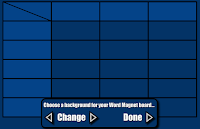Where the Wild Things are is an old favourite book of mine and one that I have used with classes many times. The movie is due out on the 3 December 2009 (in NZ) which will renew interest in this old classic. A few years ago I developed some activities using the context of the book and integrated it into the maths we were doing at the time; tessellations and rotation. The skills students learned from working with shapes enabled them create their own Wild Things.
Build a Story: Activity Six
A to Z of Wild Things: An example
Saturday, October 17, 2009
Wednesday, October 7, 2009
Editing Writing, Telescopic Text and Magnetic Writing
Teachers want to know ways to engage students in editing their own writing. If you have a projector, whiteboard (or even better an IWB) try this.
Start off with Joe Davis's site http://www.telescopictext.com/
I ask students to describe what the tea could taste like, write some answers above the text, then click on the word 'tea'. New text will be inserted into the sentence.
We carry on in this mode predicting, describing and analysing the new edited text until we can go no further.
The next day we can look at this website which is based on Joe Davis's site http://basseq.com/fun/telescopictext/
Now we can add our own words by replacing the text that is already there by highlighting the word to be changed, click on Replace, type new word and then click on Submit changes.
The third day can then be spent looking at Tripticos Word Magnet site.
Type in a sentence. When you type in the full stop make sure there is a space between it and the last word.
Click Next.
 In the next window you can choose from many different backgrounds but for my editing lesson I will keep to a blank page
In the next window you can choose from many different backgrounds but for my editing lesson I will keep to a blank page
Click on Done and the next page will appear with your text broken up into text boxes. Click and drag them up to make a sentence.
Now start adding new words by typing in the 'Add new magnet box', once you have clicked the + symbol, click on a colour to change the colour of your text box. Drag it into the correct place. Use the colour coding to identify adjectives, conjunctions etc.
This is a great way to get students interested in editing their work and to see how a sentence can come alive. These are the type of activities that I like to use with children as part of my modelling and teaching.
This will work well with just a projector and computer, but the Interactive Whiteboard would allow students to take over the manipulation of text and objects.
Start off with Joe Davis's site http://www.telescopictext.com/
I ask students to describe what the tea could taste like, write some answers above the text, then click on the word 'tea'. New text will be inserted into the sentence.
We carry on in this mode predicting, describing and analysing the new edited text until we can go no further.
The next day we can look at this website which is based on Joe Davis's site http://basseq.com/fun/telescopictext/
Now we can add our own words by replacing the text that is already there by highlighting the word to be changed, click on Replace, type new word and then click on Submit changes.
The third day can then be spent looking at Tripticos Word Magnet site.
Type in a sentence. When you type in the full stop make sure there is a space between it and the last word.
Click Next.
 In the next window you can choose from many different backgrounds but for my editing lesson I will keep to a blank page
In the next window you can choose from many different backgrounds but for my editing lesson I will keep to a blank pageClick on Done and the next page will appear with your text broken up into text boxes. Click and drag them up to make a sentence.
This is a great way to get students interested in editing their work and to see how a sentence can come alive. These are the type of activities that I like to use with children as part of my modelling and teaching.
This will work well with just a projector and computer, but the Interactive Whiteboard would allow students to take over the manipulation of text and objects.
Subscribe to:
Posts (Atom)








